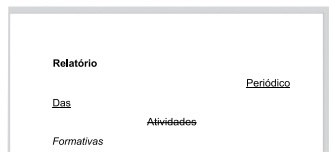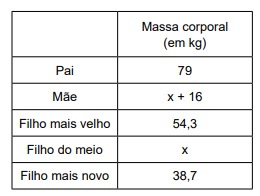Questões de Concurso
Comentadas para prefeitura de são bernardo do campo - sp
Foram encontradas 589 questões
Resolva questões gratuitamente!
Junte-se a mais de 4 milhões de concurseiros!

Assinale a alternativa que correlaciona corretamente uma palavra com uma respectiva formatação de Fonte e um respectivo alinhamento de parágrafo, de acordo com a imagem.
A tabela apresenta algumas informações sobre as massas corporais dos 5 membros de uma família.

Sabendo que a média aritmética das massas corporais
da mãe e do pai supera em 24,5 kg a média aritmética
das massas corporais dos 3 filhos, a média aritmética das
massas corporais dos 5 membros dessa família é
Se o leitor, depois de ler um destes livros, ficar mesmo mais feliz, mais bem-sucedido, mais amado e mais rico, então me curvo.
A conjunção “Se”, em destaque, estabelece uma
Leia o cartum para responder à questão.

(https://www.lingvolive.com)
In the cartoon,
It is correct to state that, in the context given,
Leia o texto para responder a questão.
English as a Lingua Franca
A number of researchers have studied conversations in English as a Lingua Franca and have noted a number of somewhat surprising characteristics, including:
• Non-use of third person present simple tense -s (She look very sad).
• Interchangeable use of the relative pronouns who and which (a book who, a boy which).
• Omission of articles where they are mandatory in native-speaker English.
• Increasing of redundancy by adding “inexistent” prepositions (We have to study about…, The article treats of…).
• Pluralisation of nouns which are considered uncountable in native-speaker English (informations, staffs).
The evidence suggests that non-native speakers are not conforming to a native English standard. Indeed they seem to get along perfectly well despite the fact that they miss things out and put things in which they ‘should not do’. Not only this, but they are actually better at ‘accommodating’ - that is, negotiating shared meaning through helping each other in a more cooperative way - than, it is suggested, native speakers are when talking to second language speakers (Jenkins 2004). In other words, non-native speakers seem to be better at ELF communication than native speakers are.
(Jeremy Harmer, The practice of English language teaching. Adaptado)
Leia o texto para responder a questão.
English as a Lingua Franca
A number of researchers have studied conversations in English as a Lingua Franca and have noted a number of somewhat surprising characteristics, including:
• Non-use of third person present simple tense -s (She look very sad).
• Interchangeable use of the relative pronouns who and which (a book who, a boy which).
• Omission of articles where they are mandatory in native-speaker English.
• Increasing of redundancy by adding “inexistent” prepositions (We have to study about…, The article treats of…).
• Pluralisation of nouns which are considered uncountable in native-speaker English (informations, staffs).
The evidence suggests that non-native speakers are not conforming to a native English standard. Indeed they seem to get along perfectly well despite the fact that they miss things out and put things in which they ‘should not do’. Not only this, but they are actually better at ‘accommodating’ - that is, negotiating shared meaning through helping each other in a more cooperative way - than, it is suggested, native speakers are when talking to second language speakers (Jenkins 2004). In other words, non-native speakers seem to be better at ELF communication than native speakers are.
(Jeremy Harmer, The practice of English language teaching. Adaptado)